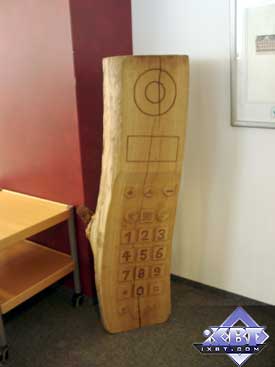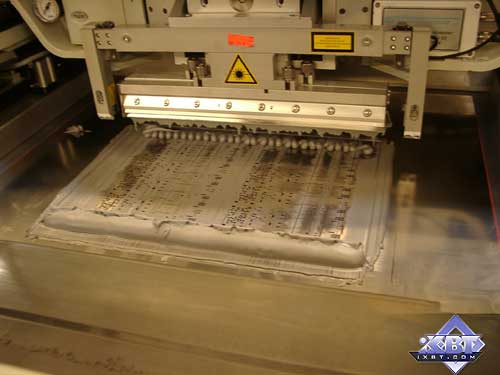The plant where Siemens produces DECT phones is
located in Bocholt (Germany), an hour of driving from Dusseldorf.
It is the only plant of the company that manufactures DECT devices,
and one of a few in Europe. The town the factory is situated in
is not large, there are only 40,000 inhabitants. The plant employs
3,585 people, where 2,734 are workers and others are administrators,
developers and engineers. The plant was founded in 1941 and worked
for the German army. In the end of the war the factory was severely
damaged and was recovered only in 1946. By 1948 the production of
wired phones was set going, mainly thanks to the help of local people.
In general, they were specialists which had been working at the
plant from the very beginning. The factory worked without any changes
up to 1997 when a new production shop, 10,000 sq. m., was built.
The new facilities appeared due to a growing popularity of the DECT
standard and DECT wireless phones. Let me dwell on the history of
development of Siemens' DECT phones.
In 1991 the plant was still producing analog devices
of the Megaset series (Models 900 and 910). Two years later a new
series, Gigaset, was added to its arsenal, and the first model -
Gigaset 1000 was released. As the product turned out to be successful,
next year the company launched its modification - Comfort which
possessed several new technical characteristics. At that time there
were primarily two basic types - Classic and Comfort, which didn't
differ much from each other (the differences related only to the
convenience in use). In 1998 Siemens developed a new model - Gigaset
Pocket, the first DECT phone of small dimensions (110 cu. cm.) comparable
to contemporary cell phones in this parameter. The Micro line extended
this direction. In 2000 the DECT standard began supporting a lot
of other products apart from phones. The brightest example is a
home automatic telephone exchange supporting up to 10 receivers
and 2 ISDN lines. Today there are many devices using the DECT technology,
for example, Siemens Simpad SL4 web-pad. The DECT line now includes
Siemens 4010, 4015 of the Classic, Comfort and Micro series.
The first thing that catches your eye is a great
deal of ads of cell phones manufacturers. On the photo you can see
a huge advertisement hoarding mounted against the entrance. A great
variety of smaller posters are spread all over the territory of
the plant.


In the checkpoint hall there are several stands
with different phone models and a screen which plays ads of new
handsets. In the office building you can see a phone made of unbroken
wood.

Having put on overalls we take a few steps and
get into a production shop. It is rather quiet here, the floor is
covered with antistatic coating since components of phones and assembled
devices are sensitive to statics.
The first line produces phone cases. In fact, all
lines can manufacture any current model. On the photos below you
can see how presses form blanks which are afterwards driven to the
production line by conveyers. The front panels are manufactured
in two stages as they have dirrerent trims; they are also pressed
but at the second stage.







After that cases are checked to meet the quality
requirements and then delivered to the next pipeline to get labeled.

You can draw any mark you like, but it will be
profitable only if there are not less than 50,000 phones. The largest
part of investments is required not for changing a logo but for
changing information in all Siemens' catalogs.
Another line deals with processing of printed-circuit
boards for future phones. One plate houses 8 blanks. The boards
have 6 layers, at the first stage they are covered with conductor
lines and then with solder to fix components.





In front of the production lines you can see an
amusing poster with a an appeal to increase labor productivity.

After that small components are set onto the boards;
they are put into tapes wound round reels. First these minor details
are not soldered to; on the photo you can see how small they are.
Then it is a turn of larger components and only after that all of
them are soldered to the board. By the way, the machines installing
the components on the boards are developed by Siemens and are said
to be quite popular with various firms and companies all around
the world.





In a special chamber the solder melts and gradually
fixes components. The temperature increases in 8 steps, then drops
in 2 steps and then the plate is sawn into 8 boards. The quality
control is carried out at each stage. The lines are almost completely
automated, and in case of any problem they either produce a signal
or stops working until an operator solves the problem. Above the
most of the lines there are three-color lamps looking like traffic
lights. If everything is OK, the green is on, in case of an uncritical
fail (for example, components are over) the yellow gets on, and
the red will inform you about serious troubles. The side effect
of automation is reduction of the stuff.


The finished boards are packed in trays. Of course,
all of them are tested, and defected samples are weeded out. On
the next line the boards are set into cases: first come small details,
for example, speakers, then key-pads and after that - the boards.
Finished phones proceed to inspectors who pack them into soft paper.
Then comes the final packing and the phones go the the stock. The
workers covering phones in paper examine for any scratches or abrasions.





Then we saw how packages of the phones were stored,
and how chargers were put into the boxes.


Boxes with chargers proceed to a small line where
workers put wrapped phones into them. After that the sets are driven
by the conveyor to the last selective check-up and then go to the
stock. If a worker forgets to put some accessory such box returns
as there are electronic scales which collate weights of the boxes
with the standard one.


Here is a cart with new phones.

You see, the production process is very simple
and highly automated. The corporate culture is of the greatest importance
here which means the through control from the very beginning up
to the end. Phones produced in Europe and Asia often differ in quality.
While the technologies are the same, it is the corporate culture
which is often lacking. It is well known that European product is
almost three times dearer than a similar one somewhere in Asia.
The Siemens' representatives say that the Bocholt's plant won't
be moved anywhere in the near future. During the last year the factory
produced about 12 million DECT phones. The lines work 24 hours a
day, 6 days a week or sometimes 7 days. This is another evidence
of wide popularity of these devices.
Write a comment below. No registration needed!


































